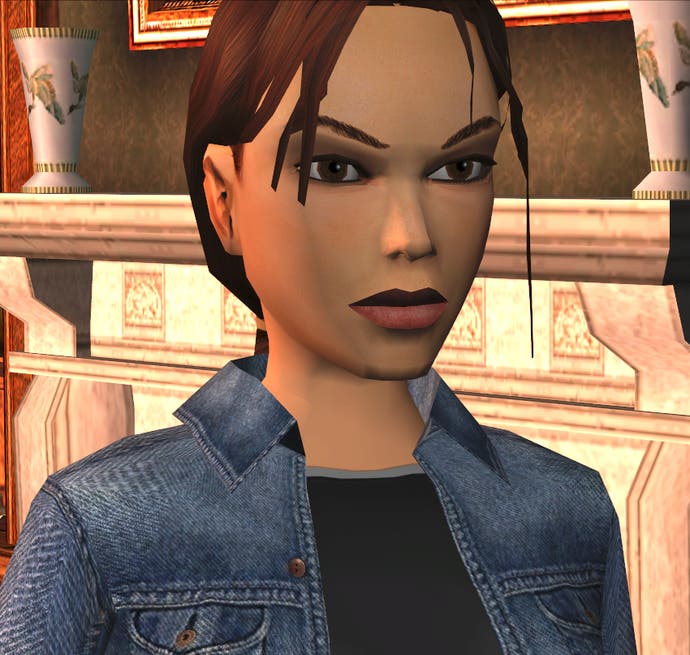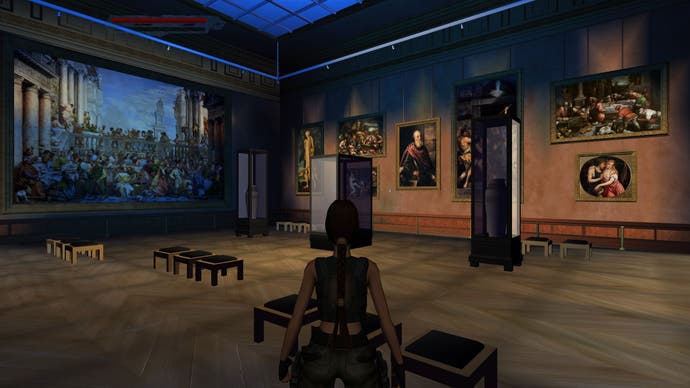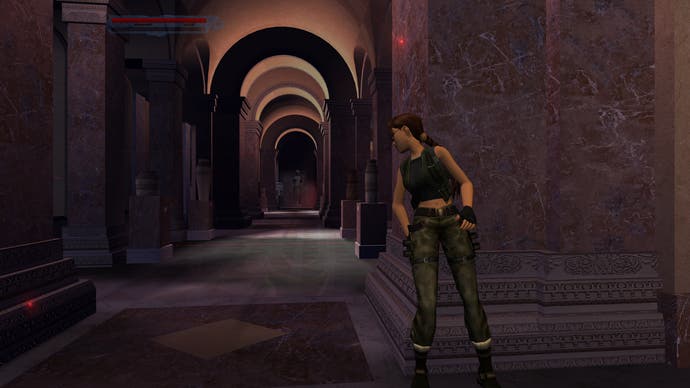The fans who would fix Tomb Raider's most broken adventure
Step into the light.
The Angel of Darkness very nearly killed Tomb Raider. It effectively condemned the long-running studio behind one of gaming's most lucrative series to an inelegant demise. It went through three years of development hell before it was rushed out unfinished in 2003, to the eternal mockery of an industry weary from grandiose promises after five prior games that all looked, sounded and played much the same.
Yet its devotees insist the game was hard done by in the rush to release, that The Angel of Darkness never got a fair shake because of its myriad launch bugs and glitches and because of the difficulty of developing for the PlayStation 2.
"If you look at everything Angel of Darkness tried to achieve and was mocked for," argues the HD remaster Facebook page owner AJ.R, "most games today actually use what it tried to build from the ground up." Angel of Darkness' dark tone, its RPG mechanics, stamina meter and generous blending of horror, action, adventure and platforming genre conventions have certainly become commonplace in recent years.
"If Core were given only six more months of development time," AJ.R continues, "it would be a completely different Lara Croft on the market today."
AJ.R is under no illusions about Angel of Darkness's problems, but he believes it was given short shrift by critics back in 2003. Kristan Reed's Eurogamer review called it "a marked backward step" and a "half-baked, unfinished travesty" that was DOA for all except the most dedicated Tomb Raider fans. "Games today get away with what Angel of Darkness couldn't back then," AJ.R says. "I've talked to people who worked on the game, and when I think of what Angel of Darkness could have been it truly kills me because it could have not only been the best Tomb Raider game back then but also the best game on the PS2."
Look past the busted controls and the glitches and Angel of Darkness is a mess of unfulfilled ambition. The environments are brimming with detail that's offset by texture and clipping issues and frequent stoppages for loading, while none of the laundry list of new mechanics - including, but certainly not limited to, a basic dialogue system, ability upgrades, stealth manoeuvring, and a second playable character - seems fully implemented.
That's just a fraction of what was planned at the beginning of development, too. Two of its four sprawling locations were cut a year into the project, while the planned story arc had to be chopped up and hastily reworked. And some of the smaller cut content, such as falling snow in the PC version of the Monstrum Crime Scene level, was completed but nonetheless omitted in all of the chaos of deadlines.
AJ.R tells me there are also more than 100 animations that didn't make the released game, as well as "countless" voice samples and objects.

He wants this cut content restored. His Facebook page, which has over a thousand likes at the time of writing, highlights the game's strengths and the community's modding efforts. "I wanted our voices to finally be heard and to show the fan base is still alive after 11 years," he says. The end goal is to persuade Square Enix to greenlight an HD remaster. But only if it's done correctly.
AJ.R doesn't trust Crystal Dynamics to stay true to Core's original vision - "when Crystal Dynamics took over it was just like Hollywood buying out your favourite TV series and dumbing it down to cater to a market it wasn't aimed at originally" - so he would only support the old team running the show. "They're still around," he says, "and some I talked to have stated numerous times they would love to work on finishing the game."
He thinks it might even be feasible now, too. "We live in the downloadable gaming era; they could easily re-release it as a side game similar to Guardian of Light [or as] a downloadable title in episodes," he says. But others aren't so confident. Tomb Raider is a Crystal Dynamics operation now, and Lara's heading off in a new direction with an all-new backstory. "And even if they did remake it for the fans," Angel of Darkness modder and amateur filmmaker Bob 'TRJTA' Smolders points out, "I think most of the people on the internet and everywhere would be like 'oh god, not that game again.'"
It turns, then, to the fans. The hero of the movement to right Angel of Darkness's reputation calls himself sasho648 (known simply as "Sasho" to the rest of the Tomb Raider community). He popped up on the Tomb Raider Forums in 2010, unceremoniously declaring that he was improving the first level.
Angel of Darkness was one of Sasho's earliest gaming experiences (he was five years old at the time). "One day I decided to replay it," he recalls. "I found the hidden area in the first level, the dual pistols and other secrets." Hidden features and mysterious secret areas struck him as enticing, and the beta videos on YouTube showed there was more to find. The problem, however, was that even with a community-made tool to extract the game's levels, Angel of Darkness's data was locked away in non-human-readable binary files.

Sasho taught himself everything he needed to know to modify the game, first in a hex editor and then with C++ and the Win32 API. He trawled through code in search of objects or areas hidden in the final release and then restored or modified them. There were missing doors and entire sections of levels that had been cut in Core's race to get a functional build out to the world, and by poking around and tweaking values he could bring them back.
He also found some stranger quirks. "There was an unused openable bin lid kept in the game," he tells me. "[But] everything I've discovered in this game was so exciting to me.... There was even an in-game scripting API which could've been provided with a game SDK [for easy modding of characters and the welcome screen]."
Huge swathes of code were written and left unfinished, for what Sasho says are "many features from which only a small part [were] actually used." Some omissions had a more telling effect on the player experience.
"[Sasho] found out in the code that the speed at which Lara runs in the final game was like 80 or 70 per cent of the speed the original animation has," Smolders says. "They were planning on upgrading the speed Lara runs at too, like with the distance she can jump and things she can push. But somehow they never managed to get that into the game.
"So what Sasho did was he just somehow in the code made it so that the animation runs at 100 per cent of the original speed."
As impressive as his level editing and digital archaeology is, though, Sasho's importance to the community rests squarely on his patches - as it is those that are giving Angel of Darkness a new lease of life. Besides fixing Lara's running speed, he's patched in a graphical filter that applies when Lara's health is low. He restored many of the moves that had animations made for them but for whatever strange reason were left out by the developers - the 180 degree walk/run turn perhaps most notable. He's also added collision detection in places where it was missing.
Most importantly, Sasho fixed the sluggish controls. No longer is it a trial just to get Lara to do what you want; she now reacts quickly, and the camera fights you less.
Sasho's not the only one improving the game. "One day someone posted videos from the Japanese PC release," recalls modder Slayer. It didn't have the graphical glitches and flipped textures he'd come to recognise after years of repeated playthroughs.
"After some research and help from Suikaze Raider I found that multiple builds were released," Slayer continues. "Nowadays seeing a day one patch that is a few hundred megabytes or even a gigabyte is the norm. Unfortunately, things weren't as simple back in 2003. Core made three patches after release (called build 42, 49 and 52), but they were mainly newer versions of the game's executable (around 5 MB each)."

Each build had newer level files corresponding to it, but only the executable files were released online while the fully-patched versions were sent to print. Still following? It gets even more confusing. "Newer didn't necessarily mean better," SLAYER explains. "Some of the newer files had glitches that didn't exist in the original release."
He painstakingly went through each level in each of the three different builds, then compiled the best - least buggy and glitch-filled - versions into one pack. In some levels he went a step further, using a special tool that packs and unpacks the .GMX level files to combine two different versions into one. "I also added a few things I made for my own use years ago," he notes, "like correct character models."
Slayer's Ultimate Patch works as a complement to Sasho's control and animation fixes, but opinions differ on just how much the two fan-made updates do to bring The Angel of Darkness up to snuff.
"It's definitely less annoying to control and, well, there's less holes in the walls," says Slayer, "but it's still the same game. You still have the tank controls and the RPG elements that don't make sense [and] you still run around in a small neighbourhood split into smaller chunks - with loading screens and all - because the game can't handle rendering it on the go."
Bob Smolders is more upbeat. "It's really one of the main things the game needed because the controls were quite slow and unresponsive," he says. This was a particular sore point for Smolders because he's been working on an HD graphics patch for the past year and a half and Lara's sluggishness slows him down as he scouts for details to improve.
Smolders runs the game through a tool called TexMod, which enables him to grab the texture files he wants to work on. He picks the ones he thinks "really stand out in their blurriness." He then sorts these into folders so he knows where they came from (which is kind of crucial in putting them back in) and scales them up in Photoshop.
"Then I mostly search for photos on the Internet," he explains. "Like for example when I have a texture of a concrete wall, I search on Google for 'concrete wall' and I import that photo into Photoshop and do all kinds of tricks with the layer style. I mostly blend some parts of the original texture with the detail of the photo. And that's a really nice way to keep the look of the original texture."
Sometimes the whole process will take just 15 minutes, but it really depends on the texture. "There was one texture from Parisian Backstreets where there were all kind of buildings in the distance on one texture map," Smolders explains. "So there's like, I don't know, maybe 50 textures on one texture map. I really don't want to know how much time I spent on that."
Smolders' motivation comes from a place of love - "it's the best game of the classics, with a great story and absolutely amazing atmosphere" - but also of frustration. As much as he loves AoD, and modding in general (he also mods the Elder Scrolls games), some things he sees nag at him. He wishes they were different. "I think if they just did that it would make the game so much better," he admits. "So I try to improve those things."
It's a sentiment shared across the Angel of Darkness fan community, it seems, with everyone united under the same banner - that Angel of Darkness could and would have been a spectacular game, if only its developers had had more time, and until the outside world wakes up and decides to right this wrong it's down to the fans to carry the torch. But they don't just carry the torch placidly. Many dig through beta builds and PC files in search of more lost content while others, like Sasho and Slayer and Rewak, work tirelessly to fix the issues themselves.
The sad part of it all, though, is that even this might not be enough. Sasho's decompiling project recently hit a major roadblock. In order to continue, he needs either enough time and patience to manually decompile the whole binary - with a significant chance of error forcing him to start over - or full specifications for the Microsoft-proprietary .PDB file format - which would enable splitting the .exe binary into small parts that can be tested independently.
"If Microsoft release it," he says, "I could continue my work." Otherwise the buck passes to another in the community: someone else with a brain wired for coding and that same desire to bring The Angel of Darkness into the light.



